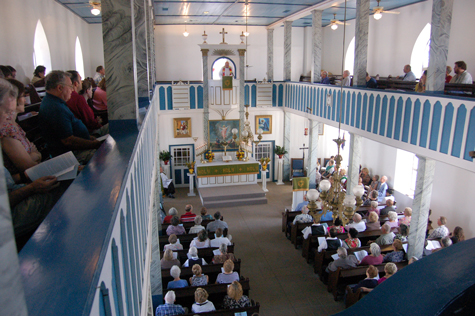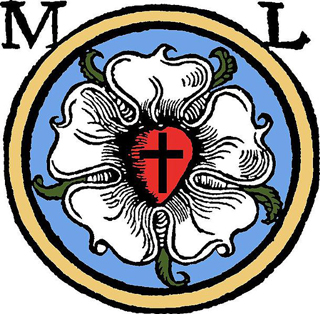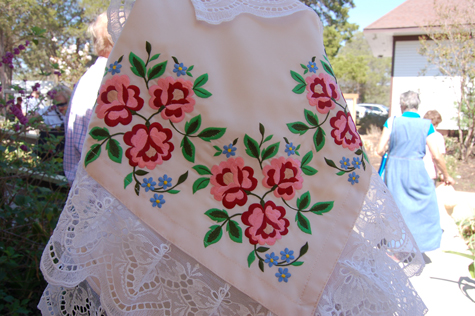Human Flower Project
Wendish Roses
Wendish heritage is strong on noodles, Lutheranism, coffee cake, and roses.

Window of the Luther Rose: St. Paul’s Lutheran Church, Serbin, TX
Photo: Human Flower Project
St. Paul’s Lutheran Church in tiny Serbin, Texas, looks severe as a whitewashed Amish barn, but inside it shines likes a sapphire. The sanctuary really glowed Sunday with two services, part of the town’s celebration of its Wendish heritage.
Pastor Robert L. Hartfield had come all the way from Pennsylvania to preach the German sermon. He remembered the faith and courage of Johann Killian, another Lutheran minister, who led a group from near the Spree River through to Liverpool, Ireland, and on to Texas in 1854. The Wends, a Slavic people from the northeastern part of today’s German nation, risked their lives to sail away for many reasons, primarily so they could go on practicing their hard line Lutheranism after the German state required all churches to come into one more moderate Protestant union.

From the balcony at St. Paul’s Lutheran Church, Serbin, TX, Pastor John Hatfield delivered the sermon in German from the high pulpit.
Photo: Bill Bishop
What makes this a human flower project? First, the Luther rose, rendered in stained glass and beaming behind Pastor Hartfield as he spoke from the second story pulpit.
We understand that this emblem became Martin Luther’s personal seal. The white rose came to be associated with Luther after 1520, when a woodcut of the flower was printed on one of his sermons. Ten years later Lazarus Spengler designed a more elaborate emblem: a black cross on a red heart, surrounded by a simple white rose floating in a blue field.
Here Luther thanks the artist and parses the image:
Grace and peace from the Lord.
As you desire to know whether my painted seal, which you sent to me, has hit the mark, I shall answer most amiably and tell you my original thoughts and reason about why my seal is a symbol of my theology.
 The Luther Rose
The Luther Rose
Image: via wiki
The first should be a black cross in a heart, which retains its natural color, so that I myself would be reminded that faith in the Crucified saves us. “For one who believes from the heart will be justified” (Romans 10:10).
Although it is indeed a black cross, which mortifies and which should also cause pain, it leaves the heart in its natural color. It does not corrupt nature, that is, it does not kill but keeps alive. “The just shall live by faith” (Romans 1:17) but by faith in the crucified.
Such a heart should stand in the middle of a white rose, to show that faith gives joy, comfort, and peace. In other words, it places the believer into a white, joyous rose, for this faith does not give peace and joy like the world gives (John 14:27). That is why the rose should be white and not red, for white is the color of the spirits and the angels (cf. Matthew 28:3; John 20:12).
Such a rose should stand in a sky-blue field, symbolizing that such joy in spirit and faith is a beginning of the heavenly future joy, which begins already, but is grasped in hope, not yet revealed.
And around this field is a golden ring, symbolizing that such blessedness in Heaven lasts forever and has no end. Such blessedness is exquisite, beyond all joy and goods, just as gold is the most valuable, most precious and best metal.
This is my compendium theologiae [summary of theology]. I have wanted to show it to you in good friendship, hoping for your appreciation. May Christ, our beloved Lord, be with your spirit until the life hereafter. Amen.

Helga Kruegermann’s Wendish head scarf, Serbin, Texas 9/25/11
Photo: Bill Bishop
We spotted yet more glorious human flowers in Wendish costume, the embroidered headdresses worm by a dance troupe that had bussed in from Harris County, and by a lovely lady who sat next to us in the church balcony. She turned out to be Helga Kruegermann of Los Angeles. Helga and her husband Kurt, native Wends, own Kruegermann Pickles, having emigrated their family business from the Spree river region of then-East-Germany in 1961. It turns out that they, and their pickles and sauerkraut, are regulars at the Texas Wendish festival.
In contrast to the many Catholic church picnics we’ve attended in this part of Central Texas, there were no games of chance (bingo, cake walk, spinning wheel, raffle) and very little in the way of spontaneous dancing, though the Kovanda Czech Band puffed and squeezed with gusto. The dance floor was actually covered with picnic tables, and the meal was terrific: sausage, sauerkraut, peaches, beets, green beans, pickles, bread and delicious locally made noodles – as well as a kazillion types of coffee cake.
And in spite of the Texas drought, the Wendish flowers, both sacred and secular, were in full bloom. There were even a few schoolhouse lilies flowering outside the museum, the first we’ve seen this fall.

